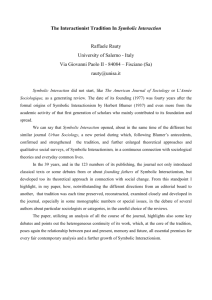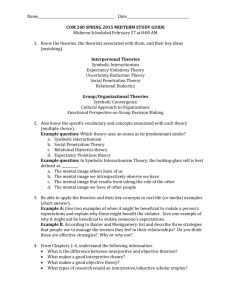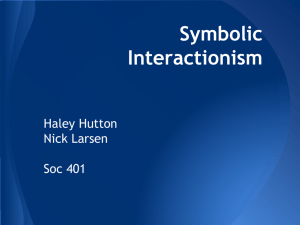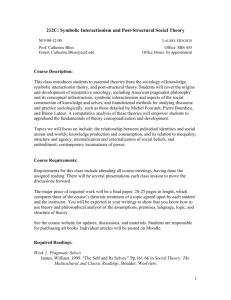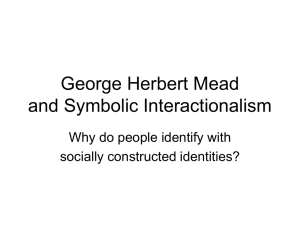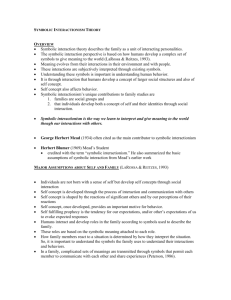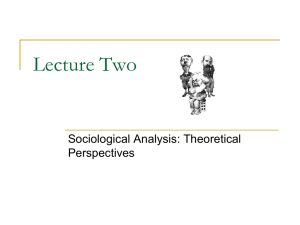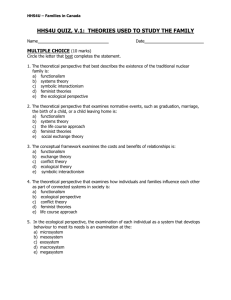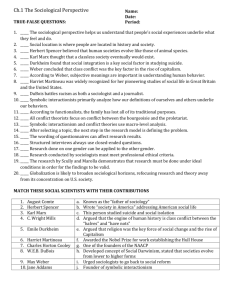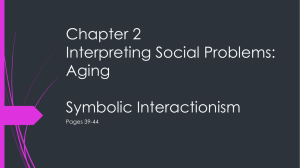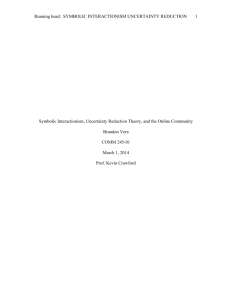Symbolic Interactionism and Looking Glass Self
advertisement
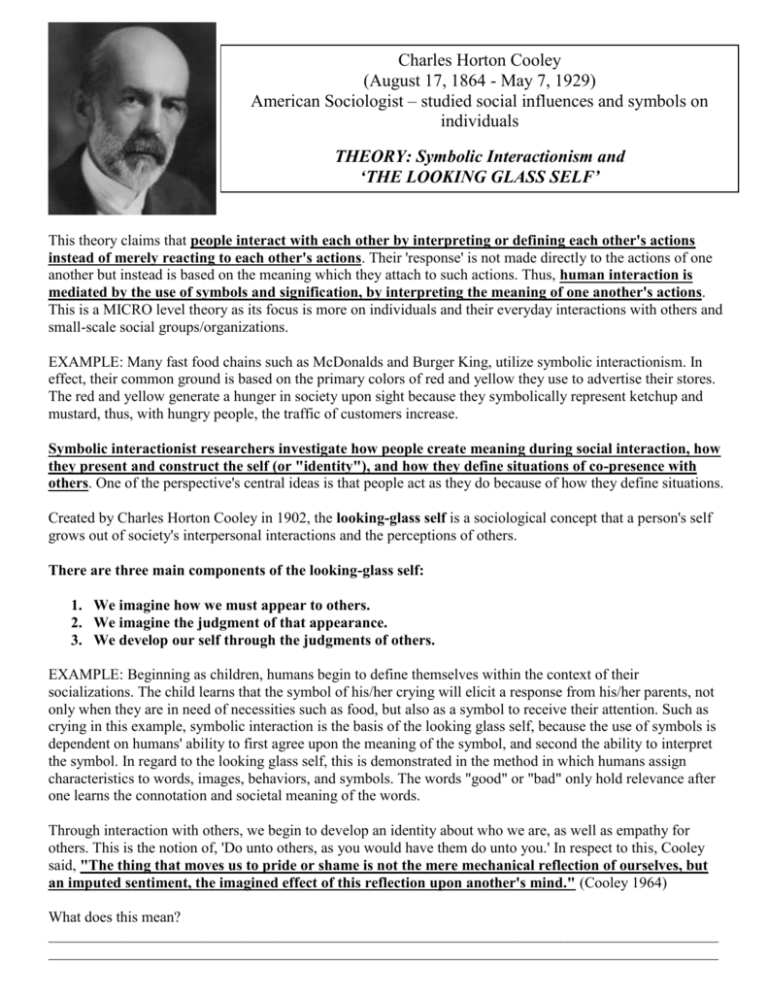
Charles Horton Cooley (August 17, 1864 - May 7, 1929) American Sociologist – studied social influences and symbols on individuals THEORY: Symbolic Interactionism and ‘THE LOOKING GLASS SELF’ This theory claims that people interact with each other by interpreting or defining each other's actions instead of merely reacting to each other's actions. Their 'response' is not made directly to the actions of one another but instead is based on the meaning which they attach to such actions. Thus, human interaction is mediated by the use of symbols and signification, by interpreting the meaning of one another's actions. This is a MICRO level theory as its focus is more on individuals and their everyday interactions with others and small-scale social groups/organizations. EXAMPLE: Many fast food chains such as McDonalds and Burger King, utilize symbolic interactionism. In effect, their common ground is based on the primary colors of red and yellow they use to advertise their stores. The red and yellow generate a hunger in society upon sight because they symbolically represent ketchup and mustard, thus, with hungry people, the traffic of customers increase. Symbolic interactionist researchers investigate how people create meaning during social interaction, how they present and construct the self (or "identity"), and how they define situations of co-presence with others. One of the perspective's central ideas is that people act as they do because of how they define situations. Created by Charles Horton Cooley in 1902, the looking-glass self is a sociological concept that a person's self grows out of society's interpersonal interactions and the perceptions of others. There are three main components of the looking-glass self: 1. We imagine how we must appear to others. 2. We imagine the judgment of that appearance. 3. We develop our self through the judgments of others. EXAMPLE: Beginning as children, humans begin to define themselves within the context of their socializations. The child learns that the symbol of his/her crying will elicit a response from his/her parents, not only when they are in need of necessities such as food, but also as a symbol to receive their attention. Such as crying in this example, symbolic interaction is the basis of the looking glass self, because the use of symbols is dependent on humans' ability to first agree upon the meaning of the symbol, and second the ability to interpret the symbol. In regard to the looking glass self, this is demonstrated in the method in which humans assign characteristics to words, images, behaviors, and symbols. The words "good" or "bad" only hold relevance after one learns the connotation and societal meaning of the words. Through interaction with others, we begin to develop an identity about who we are, as well as empathy for others. This is the notion of, 'Do unto others, as you would have them do unto you.' In respect to this, Cooley said, "The thing that moves us to pride or shame is not the mere mechanical reflection of ourselves, but an imputed sentiment, the imagined effect of this reflection upon another's mind." (Cooley 1964) What does this mean? _________________________________________________________________________________________ _________________________________________________________________________________________ SYMBOLIC INTERACTIONISM THEORY The basic principles of "symbolic interactionism," are that: Human beings act toward things on the basis of the meanings they ascribe to those things. The meaning of such things is derived from, or arises out of, the social interaction that one has with others and the society. Sociologist George Herbert Mead, claimed that people interact with each and other by interpreting or 'defining' each other's actions instead of merely reacting to each other's actions. Their 'response' is not made directly to the actions of one another but instead is based on the meaning which they attach to such actions. Thus, human interaction is mediated by the use of symbols, by interpretation, or by trying to find the meaning of one another's actions Symbolic interactionism also goes beyond the simple individual into widespread industries such as marketing and fast-food. EXAMPLE - fast food chains such as McDonalds use symbolic interactionism. Their business is based on the primary colors of red and yellow they use to advertise their stores. The red and yellow generate a hunger in society upon sight because they symbolically represent ketchup and mustard, thus, with hungry people, the traffic of customers increases. Symbolic interactionist researchers investigate how people create meaning during social interaction, how they present and construct the self (or "identity"), and how they define situations of co-presence with others. One of the perspective's central ideas is that people act as they do because of how they define situations. George Herbert Mead (1863- 1931) American Sociologist – significant figure in the history of American philosophy and sociology THEORY: Symbolic Interactionism In Mead's theory he explains a few different applications of symbolic interactionism. 1) The first one is known as our "generalized other". This is the responses and expectations we pick up from people around us. It is the general idea that a person has of the common expectations that others have about actions and thoughts within a particular society. Any time that an actor tries to imagine what is expected of them, they are taking on the perspective of the generalized other. The attitude of the generalized other is the attitude of the larger community. An example of this is from the movie "Dangerous Minds," starring Michelle Pfeiffer. In this movie Pfeiffer becomes an inner-city English teacher. She is faced teaching a classroom of kids who their entire life have been brought up in "the hood" and have been looked down upon. Through a style all her own, Pfeiffer teaches these kids and makes them see they can accomplish anything they put their minds to. As a result of the responses Pfeiffer gave these children she made them believe they could succeed. She changed their generalized other from a bad prospective to a good prospective. 2) Another application of Mead's is the "study of meaning." What Mead is talking about here is that for someone to fully understand how another person views or interprets the world, that person must listen carefully to what the other person has to say and try and put themselves in their position. Mead explains this in a much simpler way by saying, "The only way to understand horses is to smell like a horse, eat from a trough, and sleep in a stall." One must imagine themselves fitting and living the role of another person to be able to understand fully their experience. In "Dangerous Minds" Michelle Pfeiffer’s character is concerned with her students and really wants to connect with them. To do this she spends time with them outside of the classroom to see what kind of life they are living. She visits them at their homes, takes them to dinner, and just "hangs out" with them. By doing this she is trying to put herself in their shoes so she can fully interpret the way they see the world. 3) The last application is known as the "self-fulfilling prophecy." This is where the expectations we have for ourselves correspond with the expectations others have for us. When others feel the same way we do about ourselves we treat this as our reality. In "Dangerous Minds" the majority of the students felt they were unsuccessful and would never succeed in anything. Having each student self-fulfill the prophecy that the other would not succeed makes that prophecy even more true.

